Homelessness in Scotland: 2017 to 2018
Information on local authority homelessness applications, assessments and outcomes.
Applications
(Tables 1 to 10)[2]
Changes over time
Changes in applications and assessments can be driven by changes in legislation, policy and practice. The increase in homelessness between 2002/03 and 2006/07 was in part a consequence of Scottish homelessness legislation[3] which extended councils’ duties to non-priority homeless households. The priority need test was abolished on 31st December 2012[4]. Meanwhile, the number of homelessness applications has decreased in more recent years from 2008/09 to 2016/17, which is likely to have been due to the impact of the introduction of Housing Options services in Scottish local authorities, with a focus on prevention[5].
Chart 1: Scotland: Number of applications and assessments under the homelessness legislation
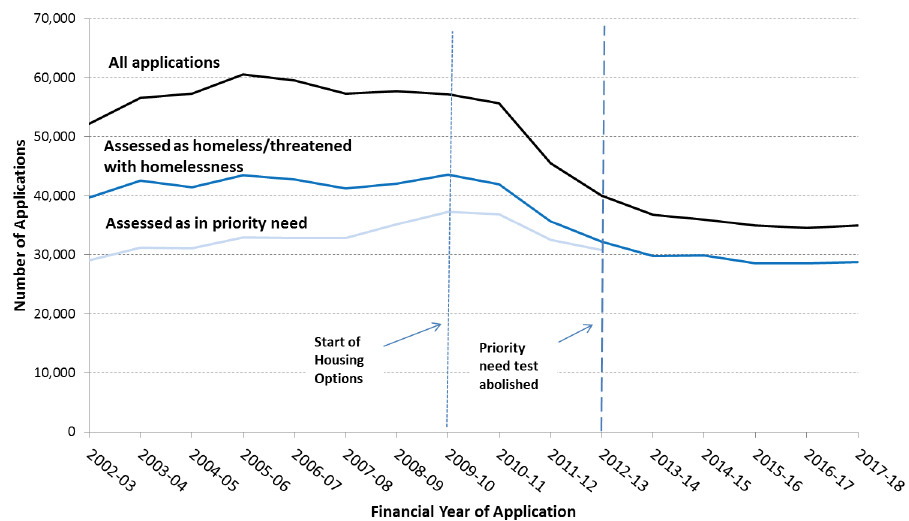
Recent trend
Between 1 April 2017 and 31 March 2018, Local Authorities received a total of 34,972 homelessness applications. This is an increase of 402 (1%) applications compared to the previous year and breaks the trend in falling numbers of homelessness application since 2008/09. The number of applications has increased in 17 out of 32 Local Authorities in the latest year (Table 1).
Housing Options work
The underlying drivers of homelessness have remained largely the same over the past few years. However, the introduction of Housing Options work is likely to have resulted in an overall decrease in the number of homelessness applications since 2009.
Impact on Applications and Assessments
There is no evidence to indicate that any one group is being impacted more by housing options work than any other. However, what is evident is that there is marked variation among Local Authorities in the frequency and delivery of this work. Scottish Government policy has been for Local Authorities to define for themselves what Housing Options is. Further statistics on Housing Options are collected through the PREVENT1 return and are available at http://www.gov.scot/homelessstats.
The proportion of homelessness applications that have been through the Housing Options route first in 2017/18 varies considerably by local authority. This reflects the locally defined nature of Housing Options.
At the Scotland level, 18,938 out of the 34,972 homeless applications (54%) received during 2017/18 had made a Housing Options approach prior to (or on the same day as) making a homelessness application. This varied widely amongst local authorities, from none in East Dunbartonshire, to 99% in Edinburgh and Clackmannanshire (Chart 2). For comparison in 2016/17, 59% of homelessness applications had made a Housing Options approach prior to (or on the same day as) making a homelessness application.
Chart 2: Proportion of homelessness (HL1) applications where a Housing Options Approach (PREVENT1) was made first, 2017-18
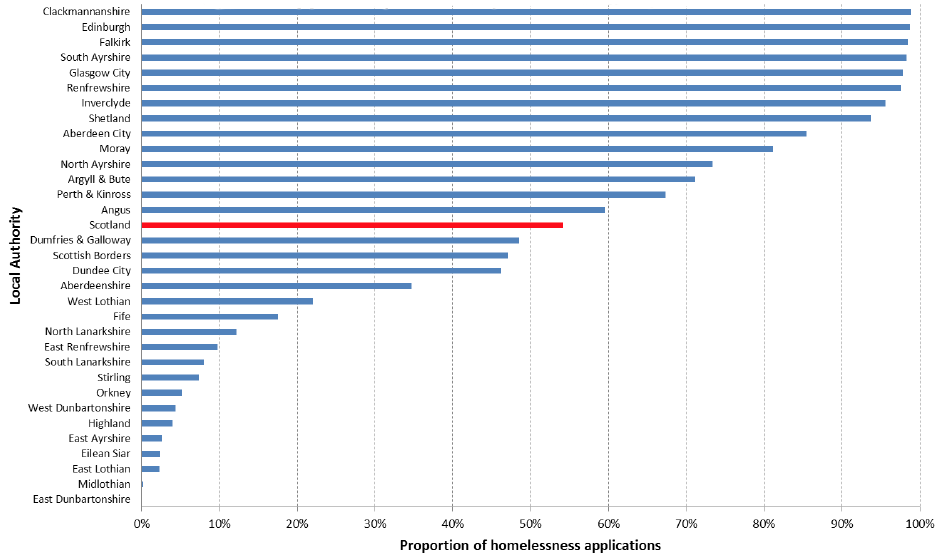
Rough sleeping (Tables 2a and 2b)
The proportion of applications where a household member reported sleeping rough at least once during the last 3 months prior to application has reduced since 2002/03, from 13% of all applications in 2002/03, to 7% in 2014/15, after which the figure has since increased slightly to 8% in 2016/17 and 2017/18.
In 2017/18, 4% of applicants (1,537 in total or 128 per month on average) slept rough the night before applying for assistance (Table 2, Chart 3). Glasgow City and Eilean Siar had the highest proportions (9% and 8% respectively). West Dunbartonshire and Midlothian had the smallest proportions of homeless applicants sleeping rough the night before.
Chart 3: Percentage of homelessness applicants in 2017/18 who slept rough the night before applying
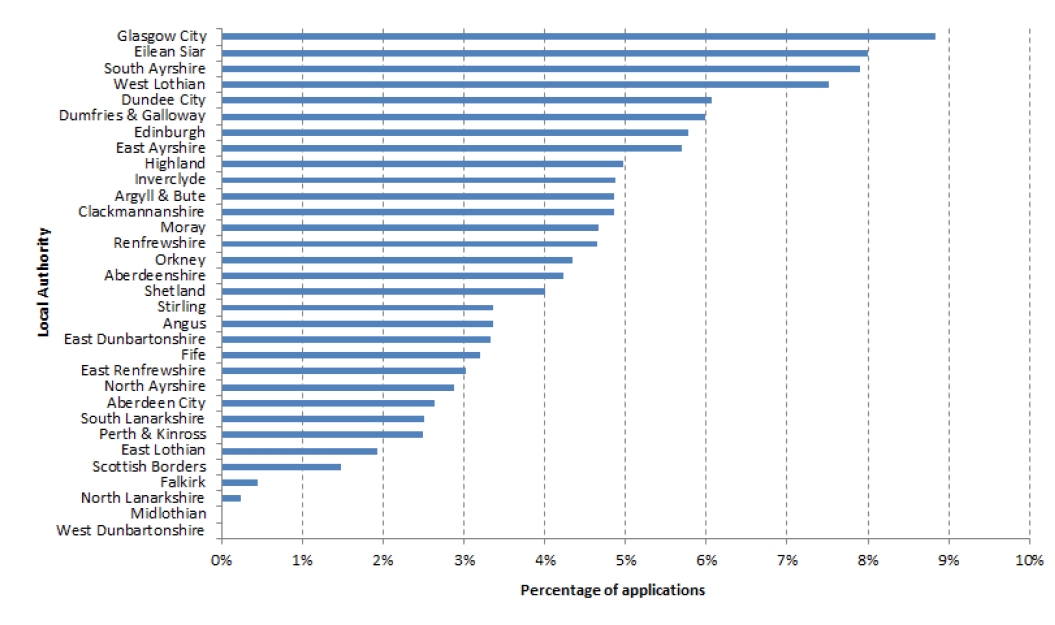
Prior circumstances of applicants
Of the 34,972 homelessness applications in 2017/18, 14,581 (42%) had been living with friends, relatives and partners, while 12,803 (37%) had been living in their own accommodation (i.e. which they either rented or owned) (Table 3, Chart 4).[6]
Chart 4: Prior housing circumstances of applications 2016-17 nad 2017-18
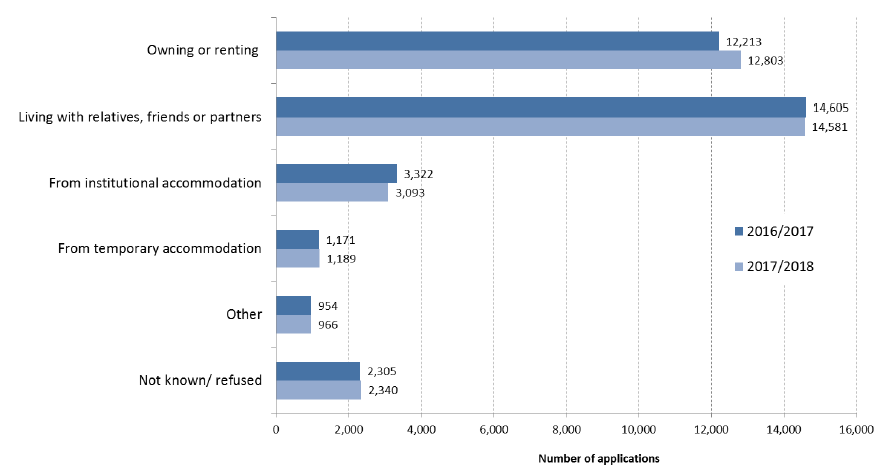
There were 1,191 applications from households that owned their own property, an increase of 101 applications (8%) compared to 2016/17 (Table 3).
There were 6,451 applications from households living in the private rented sector, an increase of 79 applications (1%) compared to 2016/17 (Table 3). Whilst the proportion of applications from the private rented sector in Scotland increased from 13% in 2007/8 to 18% in 2013/14, this proportion has since remained the same up to 2017/18.
In contrast, the situation in England is different. Households assessed as homeless who were living in the private rented sector accounted for 27% of all English homelessness assessments during October to December 2017. The ending of an assured shorthold tenancy in England has been the most frequently occurring reason for the loss of last settled home since 2012.[7]
Characteristics of applicants
Over the past decade, the characteristics of applicants have not changed much, fluctuating at most by only a few percentage points. The majority of applicants tend to be single, younger males, of White Scottish ethnicity.
Of the 34,972 applications for assistance in 2017/18:
Age and gender (Table 6)
Almost a third of applications were from those aged 25 to 34 years (32% for both male and female). The proportion of total applicants for those aged 34 and under for males was 55%, and 61% for females. This has slightly decreased over time by a few percentage points (from 63% males and 69% for females in 2002/03 for example).
Household type (Table 7)
Two-thirds of all applications (66%) were from single person households, of whom 46% were men and 21% were women. Around 28% of applications were from households with children. There were 21% of applications from single parent households, most of which were from females (80% of single parent applications)
The proportion of single parents has decreased from 24% between 2004/05 and 2011/12, to 21% in more recent years.
Ethnicity (Table 8)
88% of applicants were of White ethnicity (77% were of White Scottish ethnicity). The proportion of those identifying themselves as in Other ethnic group has increased over time, from about 1% in 2002/03 to about 4% in 2017/18.
Other (Table 4, Table 5)
About 3% were previously a member of the Armed Services (Table 4). Around 6% were formerly looked after by a Local Authority in Scotland (Table 5). Proportions of applications from these groups have largely remained the same in the past decade, although the actual numbers have reduced overall in line with overall reductions in applications.
Reasons for homelessness
(Table 9a and 9b)
The main reasons cited for having to leave prior accommodation have remained largely unchanged since 2007/08. Being asked to leave is one of the main causes of homelessness applications (25%). Dispute within the household (and relationship breakdown) is another key driver of homelessness. In 2017/18, 13% and 18% of homelessness applications come from those who have been through a violent or non-violent domestic household dispute respectively.
Some applicants (5% of all homelessness applications in 2017/18) reported that their accommodation was no longer available due to such things as rent arrears or mortgage defaults. Meanwhile, 6% of applications are from those leaving prison/ hospital/ care or some other institution.
Chart 5: Main reason for applying for assistance: All applications 2016-17 & 2017-18
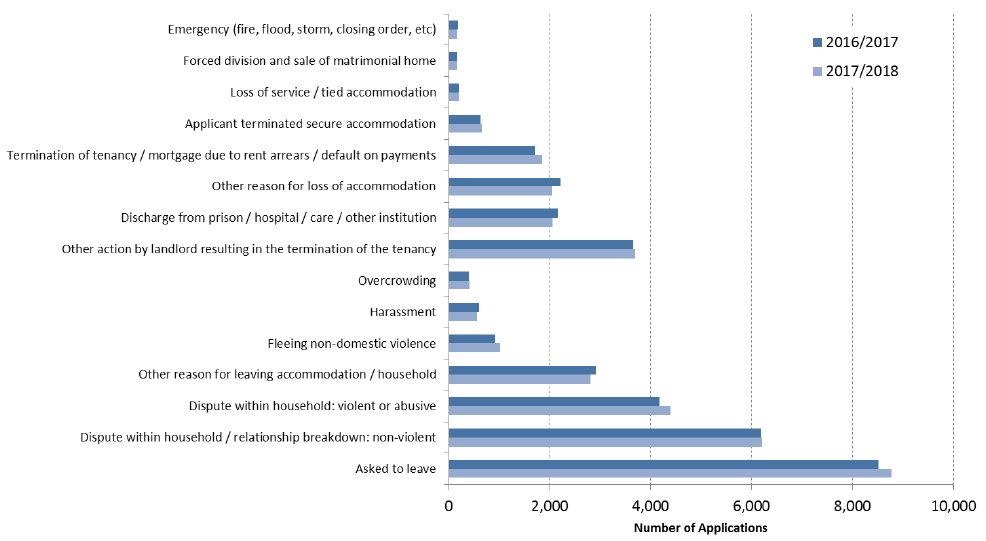
As the causes of homelessness can be complex and not the result of a single incident or event, 65% of applications cited additional reasons (22,646 out of 34,972 applications during 2017/18) (See Chart 6 and Table 10). Comparing with 2016/17, there has been a 5 percentage point increase of those citing additional reasons.
43% of those completing the question cited that their reason for homelessness was ‘not to do with the applicant household’. This includes reasons such as the landlord selling the property, fire, circumstances of other persons sharing the property or harassment by others.Other cited factors to note include ‘mental health reasons’ (23%, up from 20% during 2016/17) and ‘financial difficulties, debt or unemployment’ (18%, up from 16% during 2016/17).
Chart 6: Reason(s) for failing to maintain accommodation: Scotland
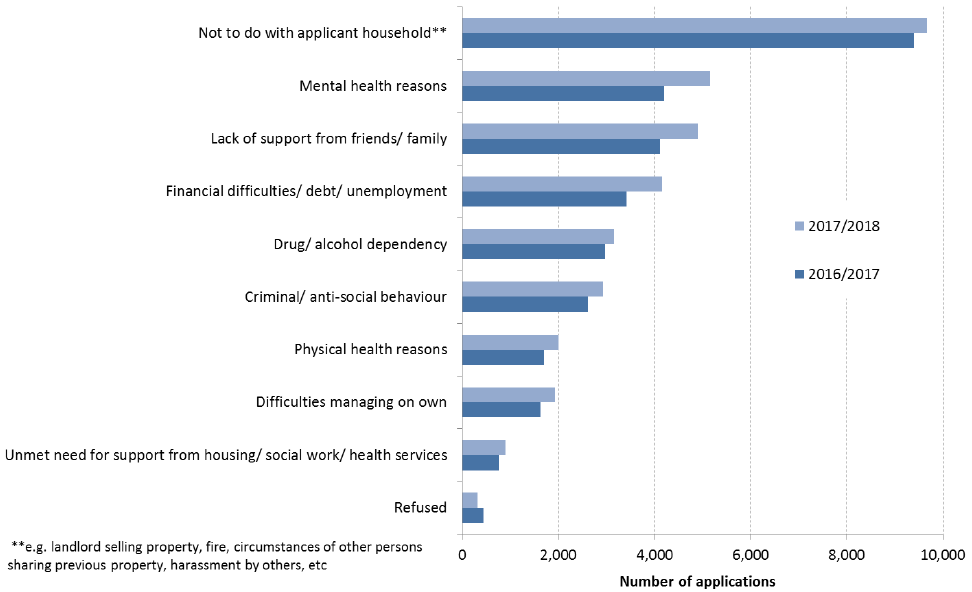
Contact
There is a problem
Thanks for your feedback